During the Great Depression in the 1930s, two producers by the names of Gene Carroll and Glenn Rowell introduced a radio show on WTAM in Cleveland, Ohio. The pair’s characters, “Jake & Lena” blew up in popularity. The pair entertained the locals through their radio show for five years during this economic worldwide depression.
The country was suffering from these dark times, and most people did not have any access to the simplest necessities for hygiene, cooking, and more so for baking.
In one episode of Gene and Glenn’s show, they invited listeners to write in their modified cookie recipes. From the recipe contributions, we get the Jake and Lena Cookies, which were later nicknamed the Poor Man’s Cookies because of the simple and cheap ingredients it uses.
Related: 15 Weird Foods That Were Common During The Great Depression
Poor Man’s Cookies are cheap, quick, and easy to make. These cookies also last quite long. Our grandparents and ancestors made these during very dark and hard times. Poor Man’s Cookies are a great addition to your prepper baking repertoire.
Making The Cookies
These cookies are made without the use of eggs, milk, and other regular ingredients used to bake cookies. But this lack of other regular ingredients doesn’t diminish the delicious flavors of the Poor Man’s Cookies.
This version of the recipe for Poor Man’s Cookies takes less than half an hour to prepare and make, and can produce a big batch of chewy and delicious cookies.
What You’ll Need:
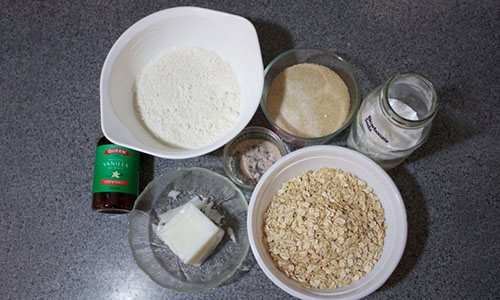
- ½ cup of shortening
- 1 cup of flour (all-purpose)
- ½ cup of sugar
- 1 cup of brown sugar (Adjust this if you want less sweetness)
- ¼ teaspoon of salt
- 1 teaspoon of baking soda
- 1 teaspoon of vanilla extract
- 2 cups of rolled oats (Or less if desired)
- ¼ cup of warm water
Preparation:
1. Melt the shortening over medium heat. Stir it continuously with a spoon until it melts. Immediately after, pour the shortening into a separate bowl or container so it doesn’t heat up too much.
2. Preheat your oven to 350 degrees Fahrenheit.
3. Combine the oats, flour, salt, and both sugars in a bowl for mixing.
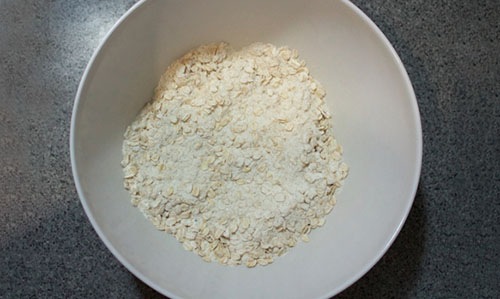
4. Mix the warm water with the baking soda. Then pour them into the mixing bowl with the shortening and vanilla extract. Stir the mixture thoroughly well.
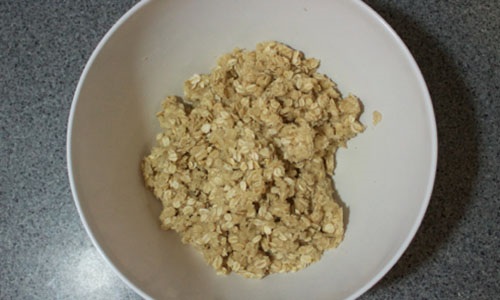 5. Roll and form the dough into small balls and place them on a tray lined with parchment paper. You can also opt to use a teaspoon to drop the dough in small shapes onto the baking tray.
5. Roll and form the dough into small balls and place them on a tray lined with parchment paper. You can also opt to use a teaspoon to drop the dough in small shapes onto the baking tray.
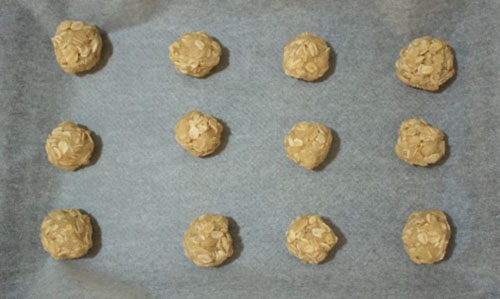
6. Place the tray into the oven and bake at 350 degrees Fahrenheit for up to 10 minutes or less. If you want browner cookies with a little more caramel taste, then you can cook them for a little over 10 minutes until it turns golden brown.
7. Remove the cookies from the oven and let them sit for about 2 minutes before you move them onto a cooling wire rack.

8. Wait around 20 minutes until the cookies are ready for eating, then enjoy!

Add Your Own Flavors
Poor Man’s Cookies became popular during the Great Depression because they were very easy to make and were a cheap food option.
⇒ The ‘Superweed’ That Saved Large Communities During The Great Depression
Now, this simple cookie recipe can be tweaked and personalized with other simple ingredients you like.
You may add ingredients such as raisins, dates, almonds, chocolate chips, coconut extract, and even mashed bananas! Just keep in mind that the more ingredients (especially wet ones) you add, the longer your baking time will be.
 Alternate Version of the Cookies
Alternate Version of the Cookies
You may also make a cookie bar-like version of the Poor Man’s Cookies with a chewy, brownie-like texture. All you need to do is follow the same steps but use a small pan (square cake pan) to bake your bars to a desired thickness or height.
Spread the cookie dough into the baking pan. (You may also lay parchment paper on the pan first before spreading the dough to make it easy to lift your cookie block afterward.) Then bake the cookies for around 15-30 minutes, depending on what texture you like.
(You may bake it longer if you want dark brown cookie bars. Or you can bake it for a shorter amount of time if you want it light.) Cut the cookie block into smaller squares after it cools.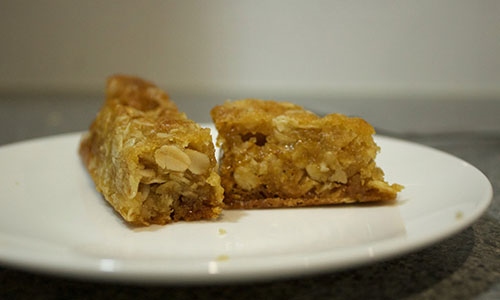
How To Store Your Cookies Properly
Most homemade cookies can last about three days at room temperature before they lose their consistency and start tasting different. Cookies will begin to harden past this point. But Poor Man’s Cookies may stay edible for a week or more before they turn stale or begin to taste bad.
And Poor Man’s Cookies may last longer if stored correctly. So, if you want to maximize your cookies’ shelf life and keep their taste, you may store them in a tightly covered container at room temperature.
Freezing the cookies for later consumption is another option. Make sure the cookies are put in a freezer-safe, airtight container or a resealable bag. Poor Man’s Cookies may last as long as three months in the freezer. Simply thaw the frozen cookies if you wish to consume them. They’ll be ready to eat once they reach room temperature. You may also heat them up instead at low heat until they reach the desired texture and temperature if you want to speed up the process.
You may also freeze or put the dough in the fridge to keep a pre-prepared batch. Raw cookie dough will last about a week in the fridge. The cookie dough may also be kept in the freezer. Keep the dough in a freezer bag or airtight container for up to three months. Thaw the dough first before you use it for baking.
Related: 11 Food Storage Lessons Learned from WWI
The Great Depression-era was one of the scariest and most troubling moments in the past century. Life was a struggle, and millions upon millions of people lost their jobs. But amid the difficulties at that time, some individuals decided to do something productive about their situation. They came up with the Poor Man’s Cookies recipe, one of the clever things to come out of that era.
Today, we are still going through a difficult time where many of us really need to adjust and learn new ways of surviving. In many lockdown situations around the world, many families didn’t have much to live with (or, in some cases, with nothing at all). They had to be resourceful with what they had and what they could get their hands on. Poor Man’s Cookies is a flavorful tried and true recipe, making it a must in every prepper’s arsenal.
You may also like:
 8 Cheap Protein Sources to Add to Your Stockpile Right Now
8 Cheap Protein Sources to Add to Your Stockpile Right Now
How Our Ancestors Survived The Great Depression (Video)
50 Tips From the Great Depression
How To Stockpile Lard, The Calorie Rich Survival Food Of The Great Depression
Who Needs the Most Food in a Crisis? The elderly? The Young? The Women?

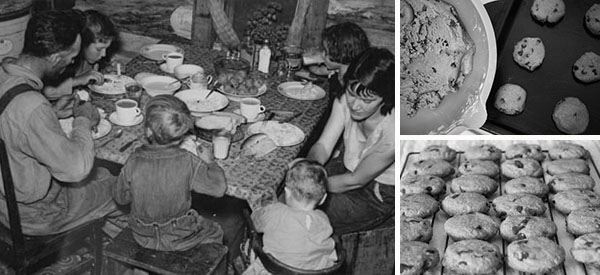













MERRY CHRISTMAS Claude, hope you and yours have a great one, stay warm, safe and healthy! thanks for this recipe, have made before and loved them!
have a great day!
Growing up during the depression would have been tough but even during and after WWII wasn’t always much better. My folks were usually employed but the depression was a fresh memory. So we made do with what we had. We picked wild blackberries and huckleberries to make jam or jelly, gathered nuts and even picked greens in the drainage ditches. When the smelt were running we caught those and dug clams every chance we could. The berries and any fruit we got often got dried and nuts were both a treat and something we added to our cookie dough, ‘Rolled oats were also added to stretch each batch too. So the depression cookies continued with dried berries and or nuts added to the batter from our somewhat meager supply. We still do the same today and we like to say that we have been preppers as small children almost from birth. Thanks for the interesting article on cookies as I was raised on. Bob
Thanks and merry Christmas! I’ll try theses, gluten free.
For brown sugar 1 Cup sugar, 1 teaspoon unsulfured blackstrap molasses. Mix well. We use the food processor.
niio!
That is a lot of ingredients!!!
I have a 3 ingredient sugar cookie recipe,
a 3 ingredient peanut butter cookie recipe,
and lots of other 3 ingredient recipes.
Gene Carroll! Great guy. Everyone here in Northern Ohio knows him. Well, that are at least 60 years old like me.
Good recipe for these cookies. Tasty, too!
Yep–the 1930s in Cleveland were tough. My Mom would tell us about all the veggies they grew in their backyard garden alongside the chicken coop.
Dad related how he and his brothers would “walk the railroad tracks” picking up lumps of coal that fell off the loaded coal cars. Everyone back then had a coal furnace or cast iron stove for heat.
Funny that: neither Mom nor Dad ever said they were poor. Each of them had at least 5 or 6 siblings–all hard workers. Any cash money or coin they got they put in a big Mason jar on the fireplace mantle. Everyone in the Family got a “vote” as to how every penny was spent.
No “foolishness” back then. Work from sunup to sundown just to stay alive, keeping body and soul together.
Later, Dad and all his brothers “joined up” after Pearl Harbor. Basic training was a cinch–plus, he said they got all the food they could eat, good britches, and stout footwear.
More funny things: Dad never spoke about the horrors he saw in the ETO. He worked the steel mills for 40 years after the Army – he was a gentle giant of a man.
Never heard Dad complain – not once; even when he cut his finger off power sawing in the barn. Just drove himself to the ER cool as a cucumber. Said not a word.
Mom used to make these. Sometimes instead of oats she’d used cornmeal. I loved both variations when she add rasins or date chunks. My preference was dates in the cornmeal and rasins with the rolled oats.
Agency man we also forraged to eat. My parents wers adults during the depression. Dad picked up odd jobs along with his dad to support the household. Mom worked in a family grocery store to support her mother and a nephew. My parents met in Florida during WWII and married in January of 1946. Mom took a train from Pensacola to meet Dad in Seattle. He was discharged from the Navy in October of 1945. He’d found a job and rented a home before he sent money to help with the travel plans. He’d earned enough money during the war cutting hair and with his homemade windmill powered washing machine that he rented a home and paid for Moms train ticket with money left over. He’d been stationed on Eniwetok, an atoll in the Pacific, with a communal outdoor shower, burried drums with a pipe and funnel for urinals around the base. He went to work building a washing machine. When officers found out he could cut hair he was in the haircutting business. He was a Naval photographer sitting in the tailgunners seat taking pictures of targets and pictures of the Japanese fleet. Then working in the darkroom. Pilots studied his pictures and papermache painted accurate models of important targets. He’d photograph from a set altitude then make model and paint it to look exactly like the target location. He had picture of his model of Truk Lagoon. It was declassified when the war ended and he kept quite a few pictures from Guam and Enowetok and a few a from Hawaii when he spent his leave times.
By September of 1946 they movd to Washington DC and Dad was going back to colIege on His Gi Bill. I was born January of 1947. September of1950 we moved to Loma Linda, CA for more clases for Dad. There Mom started taking me out foreaging for greens for our dinners. I especially liked lambquarters. January 1954 we were in Seattle for Dad to finish up his second BA and do a year of internship. He helped run the American Can Co. Food program for all employees at the seattle plant. That was tge only year ge didn’t work full time supporting us while going to school full time. He pay was $40 a month but rent was $50. Mom took a bookkeeping job at a meat packing company. We ate a lot of perfectly good meat scraps left from cutting ordered meat. Once we had so many chicken hearts that was all we ate for three weeks. I still won’t eat one. I may end up eating one diced into giblet gravy but never again just a pile of little hearts. But with depression era parents nothing was wasted.
I’m pretty much the same way. Anything we don’t eat goes to the critters or a compost pile. I still forrage for what’s available where i live. Spring dandelions to sumner lambquarters and fall Amaranth. We eat cactus pads, fruit, and plant them along the side road fence line to discourage folks from climbing the fence. Not too much to gather most of the year. Spring is a wild celery, wild onions, new sage, alfalfa along ditch bank, seasoning to dry and save and fresh and dried alfalfa for critters. In fall I collect seeds from greens for winter sprouts and some to scatter where ill want new ones growing
Merry Christmas every one.
These don’t have anything in them that should change the flavour after only a few days. Same with the dough, it should last far longer than 3 days! Nothing in it spoils easily so… I’ve made cookie dough with egg and I’ve used it as long as the eggs would have still been fresh. About 3 weeks. So these should last at LEAST that long if in an air tight container or wrapped in parchment paper.
I remember the Jake and Lena show, from reruns from later years. Gene Carroll had another show also, but I don’t remember the name. He was funny and a popular entertainer in the Cleveland area. He did shows to help various causes also.
The cookie recipe I remember very well, as Grandma baked a lot of them.
We never had dandelions growing very long, as Mom and Grandma dug them up as soon as they appeared fo make salads and add to soups. Granddad cooked the greens in bacon fat to eat with his eggs and bacon for breakfast.
Granddad knew which mushrooms were good to eat, and often brought home really weird looking fungi.
Grandma also made a “poor mans pie” made with a crust filled with a thick flour and water or milk pudding with spices and raisins, which became solid as it baked, almost the consistency of a dense bar cookie. I liked it best when she added molasses to it. I have tried making a gluten free version, but it just isn’t the same.
I loved reading the comments posted. Especially clergylady’s comments. What a great peak into history. I haven’t tried these cookies but I will. I love cookies. the easiest ones I’ve learned to cook are made with a yellow cake mix, 1/3 cup oil, 2 eggs, one tablespoon water and 2/3 cup of nuts and/or chocolate chips. My daughter sent me this recipe and I make them all the time.
Wish this was published a little bit sooner as it would have certainly made it on my Christmas Cookie Baking Agenda! The kiddies around here insist on decorating all cookies a bunch of M&Ms before they make it into the oven, which I think would be very appropriate as I understand that M&Ms were invented during WWII to provide a portable, energizing sweet treat to the troops in the field.
The sales jingle was, “They melt in your mouth, not in your hand.”
Like our language, we stole them from the Brits and made them better.
Recipe doesn’t say when you use the 1/4 cup hot water. The warm water is mixed with the baking soda, but there is no mention of using hot water.
Ronny: did you use guar gum? I mix it with xanthan. niio
I use a gluten free baking mix which has xanthan gum in it
Sorry, I guess I was thinking… destitute. I don’t see “poor” having (brown sugar, shortening, flour (all-purpose), vanilla extract) let alone have access TO an oven. Am I “missing something” ?
Ozzy: At that point, the people would have starved to death. Sugar, molasses, flour, vanilla all go a long, long way. An oven can get a frying pan and lid buried in hot ashes. Ovens are easy to make. Clay and water, hand build it. two chambers, side by side or upper and lower. fire goes in the lower one and smoke out a chimney. The upper would have a door to hold the heat. A lot of people in the world still bake like that. niio
Pine Hollow Farms’ comment about walking the tracks to pick up coal sparked a memory told by my mother and her siblings (there were 7) and the coal trains that came up thru Illinois on the way to the steel mills. The 2 oldest were boys. Coal trains were always long and when pulling even a slight grade were down to not much more and a brisk walk. The kids would take a team and wagon and wait in the brush while one would watch the track for a train. If it was long they knew it would be a slow one and just waited. When it had nearly passed the boys would run up and climb onto the last few cars and start tossing coal off onto the ground as fast as they could. The brakeman or men in the caboose never even came out to holler at them since they knew it was bad and glad to just have a job themselves. When the train started to pick up speed the boys knew it was time to get off which they did, Meanwhile moms’ oldest sister would drive the team up along the track until they came upon the coal. The younger kids got out and tossed the coal into the wagon until they caught up to the boys. My mom and her sisters wanted to climb on and toss coal but were forbidden by her father. Tossing Coal was a lot easier than lifing it up over the side of a wagon and they knew it’ This was hard coal (anthracite) headed for the steel mills and not only burned hotter but longer than soft coal (bituminous). So when they used it in the stove or heater they had to be careful not to fill either too full as it could literally burn thru cast iron plate if they had.
Back in 2011 I was out of town for a funeral. I stopped at a RR crossing to check out what looked to be a disused line. There’s still coal scattered among the ballast on that track! Just from what I saw, I imagine someone could fill a bucket with a few minutes’ walk.
Recipe skipped mixing the liquid with the flour, sugar and oats.
That’s a LOT of sugar, which makes me skeptical for a depression recipe. The only difference between it and a 1950s/60s recipe is the lack of eggs.